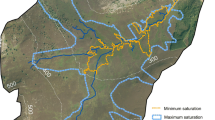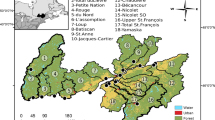Abstract
Stream DOC dynamics during snowmelt have been the focus of much research, and numerous DOC mobilization and delivery mechanisms from riparian and upland areas have been proposed. However, landscape structure controls on DOC export from riparian and upland landscape elements remains poorly understood. We investigated stream and groundwater DOC dynamics across three transects and seven adjacent but diverse catchments with a range of landscape characteristics during snowmelt (April 15–July 15) in the northern Rocky Mountains, Montana. We observed a range of DOC export dynamics across riparian and upland landscape settings and varying degrees of hydrologic connectivity between the stream, riparian, and upland zones. DOC export from riparian zones required a hydrologic connection across the riparian–stream interface, and occurred at landscape positions with a wide range of upslope accumulated area (UAA) and wetness status. In contrast, mobilization of DOC from the uplands appeared restricted to areas with a hydrologic connection across the entire upland–riparian–stream continuum, which generally occurred only at areas with high UAA, and/or at times of high wetness. Further, the relative extent of DOC-rich riparian and wetland zones strongly influenced catchment DOC export. Cumulative stream DOC export was highest from catchments with a large proportion of riparian to upland area, and ranged from 6.3 to 12.4 kg ha−1 across the study period. This research suggests that the spatial/temporal intersection of hydrologic connectivity and DOC source areas drives stream DOC export.









Similar content being viewed by others
References
Agren A, Buffam I, Jansson M, Laudon H (2007) Importance of seasonality and small streams for the landscape regulation of dissolved organic carbon export. J Geophys Res 112:G03003. doi:10.1029/2006JG000381
Agren A, Buffam I, Berggren M, Bishop K, Jansson M, Laudon H (2008) Dissolved organic carbon dynamics in boreal streams in a forest-wetland gradient during the transition between winter and summer. J Geophys Res 113:G03031. doi:10.1029/2007JG000674
Bishop K, Pettersson C, Allard B, Lee Y-H (1994) Identification of the riparian sources of aquatic dissolved organic carbon. Environ Int 20:11–19
Bishop K, Seibert J, Koher S, Laudon H (2004) Resolving the double paradox of rapidly mobilized old water with highly variable response to runoff chemistry. Hydrol Process 18:185–189
Boyer EW, Hornberger GM, Bencala KE, McKnight DM (1997) Response characteristics of DOC flushing in an alpine catchment. Hydrol Process 11:1635–1647
Boyer EW, Hornberger GM, Bencala KE, McKnight DM (2000) Effects of asynchronous snowmelt on flushing of dissolved organic carbon: a mixing model approach. Hydrol Process 14:3291–3308
Burns D (2005) What do hydrologists mean when they use the term flushing? Hydrol Process 19:1325–1327
Covino BL, McGlynn TP (2007) Stream gains and losses across a mountain-to-valley transition: impacts on watershed hydrology and stream water chemistry. Water Resour Res 43:W10431. doi:10.1029/2006WR005544
Creed IF, Sanford SE, Beall FD, Molot LA, Dillon PJ (2003) Cryptic wetlands: integrating hidden wetlands in regression models of the export of dissolved organic carbon from forested landscapes. Hydrol Process 17:3629–3648
Creed IF, Beall FD, Clair TA, Dillon PJ, Hesslein RH (2008) Predicting export of dissolved organic carbon from forested catchments in glaciated landscapes with shallow soils. Global Biogeochem Cycles 22:GB4024. doi:10.1029/2008GB003294
Farnes PE, Shearer RC, McCaughey WW, Hanson KJ (1995) Comparisons of hydrology, geology and physical characteristics between Tenderfoot Creek Experimental Forest (East Side) Montana, and Coram Experimental Forest (West Side) Montana. Final Report RJVA-INT-92734. USDA Forest Service. Intermountain Research Station, Forestry Sciences Laboratory, Bozeman, Montana, 19 p
Freer J, McDonnell JJ, Beven KJ, Peters NE, Burns DA, Hooper RP, Aulenbach B, Kendall C (2002) The role of bedrock topography on subsurface stormflow. Water Resour Res 38. doi:10.1029/2001WR000872
Hinton MJ, Schiff SL, English MC (1998) Sources and flowpaths of dissolved organic carbon during storms in two forested catchments of the Precambrian Shield. Biogeochemistry 41:175–197
Holdorf HD (1981) Soil resource inventory, Lewis and Clark National Forest, interim in-service report. On file with the Lewis and Clark National Forest. Forest Supervisor’s Office, Great Falls
Hood E, Gooseff MN, Johnson SL (2006) Changes in the character of stream water dissolved organic carbon during flushing in three small catchments, Oregon. J Geophys Res 111:G01007. doi:10.1029/2005JG000082
Hope D, Billet MF, Cressner MS (1994) A review of the export of carbon in rivers: fluxes and processes. Environ Pollut 84:301–324
Hornberger GM, Bencala KE, McKnight DM (1994) Hydrologic controls on dissolved organic carbon during snowmelt in the Snake River near Montezuma, Colorado. Biogeochemistry 25:147–165
Imai A, Matsushige K, Nagai T (2003) Trihalomethane formation potential of dissolved organic matter in a shallow eutrophic lake. Water Res 37:4284–4294
Inamdar SP, Mitchell MJ (2006) Hydrologic and topographic controls on storm-event exports of dissolved organic carbon (DOC) and nitrate across catchment scales. Water Resour Res 42:W03421. doi:10.1029/2005WR004212
Inamdar SP, Christopher S, Mitchell MJ (2004) Flushing of DOC and nitrate from a forested catchment: role of hydrologic flow paths and water sources. Hydrol Process 18:2651–2661
Jencso KG, McGlynn BL, Gooseff MN, Wondzell SM, Bencala KE, Marshall LA (2009) Hydrologic connectivity between landscapes and streams: transferring reach and plot scale understanding to the catchment scale. Water Resour Res 45:W04428. doi:10.1029/2008WR007225
Jencso KJ, McGlynn BL, Gooseff KE, Bencala KE, Wondzell SM (in review) Hillslope hydrologic connectivity controls riparian groundwater turnover: implications of catchment structure for riparian buffering and stream water sources. Water Resour Res
Johnson MS, Lehmann J, Selva EC, Abdo M, Riha S, Guimarães Couto E (2006) Organic carbon fluxes within and streamwater exports from headwater catchments in the southern Amazon. Hydrol Process 20:2599–2614
Jonsson A, Algesten G, Bergstrom AK, Bishop K, Sobek S, Tranvik LJ, Jansson M (2007) Integrating aquatic carbon fluxes in a boreal catchment carbon budget. J Hydrol 334:141–150
Kortelainen P, Saukkonen S, Mattson T (1997) Leaching of nitrogen from forested catchments in Finland. Global Biogeochem Cycles 11:627–638
Laudon H, Kohler S, Buffam I (2004a) Seasonal TOC export from seven boreal catchments in northern Sweden. Aquat Sci 66:223–230
Laudon H, Seibert J, Kohler S, Bishop K (2004b) Hydrological flowpaths during snowmelt: congruence between hydrometric measurements and oxygen 18 in meltwater, soil water, and runoff. Water Resour Res 40:W03102. doi:10.1029/2003WR002455
Laudon H, Sjoblom V, Buffam I, Seibert J, Morth M (2007) The role of catchment scale and landscape characteristics for runoff generation of boreal streams. J Hydrol 344:198–209
McGlynn BL, McDonnell JJ (2003) Role of discrete landscape units in controlling catchment dissolved organic carbon dynamics. Water Resour Res 39. doi:10.1029/2002WR001525
McGlynn BL, Seibert J (2003) Distributed assessment of contributing area and riparian buffering along stream networks. Water Resour Res 39. doi:10.1029/2002WR001521
Mincemoyer SA, Birdsall JL (2006) Vascular flora of the Tenderfoot Creek Experimental Forest, Little Belt Mountains, Montana. Madrono 53:211–222
Nakagawa Y, Shibata H, Satoh F, Sasa K (2008) Riparian control on NO3−, DOC, and dissolved Fe concentrations in mountainous streams, northern Japan. Limnology 9:195–206. doi:10.1007/s10201-008-0251-7
Neill C, Elsenbeer H, Krusche AV, Lehmann J, Markewitz D, de O, Figueiredo R (2006) Hydrological and biogeochemical processes in a changing Amazon: results from small catchment studies and the large-scale biosphere–atmosphere experiment. Hydrol Process 20:2467–2476
Pacific VJ, McGlynn BL, Riveros-Iregui DA, Welsch D, Epstein H (2008) Variability in soil CO2 production and surface CO2 efflux across riparian-hillslope transitions. Biogeochemistry. doi:10.1007/s10533-008-9258-8
Pacific VJ, McGlynn BL, Riveros-Iregui DA, Epstein HE, Welsch DL (2009) Differential soil respiration responses to changing hydrologic regimes. Water Resour Res. doi:10.1029/2009WR007721
Riveros-Iregui DA, McGlynn BL (2009) Landscape structure controls soil CO2 efflux variability in complex terrain: scaling from point observations to catchment scale fluxes. J Geophys Res Biogeosci. doi:10.1029/2008JG000885
Riveros-Iregui DA, McGlynn BL, Epstein HE, Welsch DL (2008) Interpretation and evaluation of combined measurement techniques for soil CO2 efflux: surface chambers and soil CO2 concentration probes. J Geophys Res Biogeosci. doi:10.1029/2008JG000811
Riveros-Iregui DA, McGlynn BL, Epstein HE, Welsch D, Marshall L (in review) A landscape-scale assessment of a process soil CO2 production and transport model. J Geophys Res Biogeosci
Seibert J, McGlynn BL (2007) A new triangular multiple flow direction algorithm for computing upslope areas from gridded digital elevation models. Water Resour Res 43(4):W04501
van Vevrseveld WJ, McDonnell JJ, Lajtha K (2008) A mechanistic assessment of nutrient flushing at the catchment scale. J Hydrol 358:268–287
Waterloo MJ, Oliveira SM, Drucker DP, Nobre AD, Cuartas LA, Hodnett MG, Langedijk I, Jans WWP, Tomasella J, de Araújo AC, Pimentel TP, Múnera Estrada JC (2006) Export of organic carbon in run-off from an Amazonian rainforest blackwater catchment. Hydrol Process 20:2581–2597
Wei Q, Feng C, Wang D, Shi B, Zhang L, Wei Q, Tang H (2008) Seasonal variations of chemical and physical characteristics of dissolved organic matter and trihalomethane precursors in a reservoir: a case study. J Hazard Mater 150:257–264
Wieler M, McDonnell J (2006) Testing nutrient flushing hypotheses at the hillslope scale: a virtual experiment approach. J Hydrol 319:339–356
Acknowledgements
This work was funded by National Science Foundation (NSF) grant EAR-0337650 to B.L. McGlynn, and fellowships awarded to V.J. Pacific (from the Inland Northwest Research Alliance—INRA, and the Big Sky Institute NSF GK-12 Program) and K.G. Jencso (INRA). Extensive logistic collaboration was provided by the Tenderfoot Creek Experimental Forest and the USDA, Forest Service, Rocky Mountain Research Station, especially Ward McCaughey. Airborne Laser Mapping was provided by the NSF-supported Center for Airborne Laser Mapping (NCALM). We are grateful to Diego Riveros-Iregui and Austin Allen for field assistance, and Galena Ackerman and John Mallard for performing laboratory analyses.
Author information
Authors and Affiliations
Corresponding author
Rights and permissions
About this article
Cite this article
Pacific, V.J., Jencso, K.G. & McGlynn, B.L. Variable flushing mechanisms and landscape structure control stream DOC export during snowmelt in a set of nested catchments. Biogeochemistry 99, 193–211 (2010). https://doi.org/10.1007/s10533-009-9401-1
Received:
Accepted:
Published:
Issue Date:
DOI: https://doi.org/10.1007/s10533-009-9401-1




